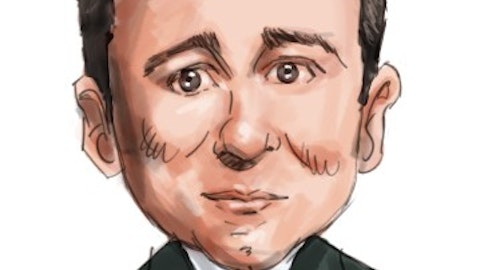Michael Perito: A lot of them have been addressed, but just two quick ones. One, Mike, on the Centric is about to close, most of your peers are saying bank M&A is pretty quiet. Just curious what you are hearing and where your thoughts are at for that heading into the start of this year?
Mike Price: We wake up every day and we think about organic growth and how we grow our company and that’s the highest and best use of our capital. So that’s where fundamentally we start and we have to be successful there year-in and year-out. And then when we have great opportunities like with Centric, with Foundation in Cincinnati, they have to be right. And Jim always likes to say, we have looked at 60 things to do six. So we are not seeing a lot of activity. And then even if we were, it would have to be right for us strategically and it would have to be right for us financially. And we are pretty picky and I don’t — so anyway, we are not counting on that if it presents itself in a way that’s really positive for our company and is a win-win and great, but it’s not a key part of our strategic plan.
Michael Perito: Great. Thanks. And then just within the non-interest income, any — obviously, the environment on mortgage and investments and everything are challenging. Just curious if there’s any particular areas that might have more or less upside relative to your forecast, anything you are excited about or more cautious about on the line item basis?
Mike Price: Yeah. I will start there and let Jane follow on Jim. But just on the SBA piece, we are a little frustrated, because we really have good volume and we are number one SBA lender in a couple of our key markets. That’s a part of our brand. We feel like we are doing good for customers and our bank and but the volume has materialized into fee income, but it will, and that business has been around for a long time. So we are still very bullish on it even though it’s kind of tamped down right now. We have grown that business pretty nicely in the volume. I will speak to that one. I spoke a little bit to mortgage. And obviously, indirect auto too or not indirect auto, but our card business is off probably about 12% and that’s just consumers not spending as much money and swiping their cards as often, at least in our part of the vineyard. Jane, what else would you add in terms of outlook for fee businesses?
Jane Grebenc: There are a couple of things I would add, Mike, that the brokerage business looks good. The Investment Management and Trust business is a little bit soft, because of the market volatility, and we are priced — we are paid against asset values and the volatility is not our friend. But none of that feels like it’s prolonged, it all feels like a blip. And to Mike’s point on, we have a couple of loans still in the pipeline, construction loans, which started in early 2020 and they just haven’t completed yet and they will. But I have stopped counting the days and I just know they will close. They are progressing. They are just progressing slowly.
Mike Price: Is that helpful?
Michael Perito: Thank you, Mike. That’s all I have. Appreciate it. Yeah.
Mike Price: Thank you.
Operator: Our next question comes from Manuel Navas with D.A. Davidson.
Manuel Navas: Hey. Good afternoon.
Mike Price: Good afternoon, Manuel.
Manuel Navas: Can you kind of talk about the loan growth target and explain a little bit more about the mix and then I will dive into the equipment finance group in a second.
Mike Price: Yeah. The mix is — we do it in two ways. We do it with geographically and we do it by product line, and more and more we are running our company geographically. And I would say that Ohio has just been on a tear, probably, average loan growth there of about 20% the last several years and then in Pittsburgh. And our community PA markets have really improved quite a bit. I mean we were leaking oil for a number of years in Community Pennsylvania and I think they grew about or 7% or 8% last year. So that’s one dimension that we look really closely at is how we are delivering geographically. And then also by lines of business, we expect our commercial to really kind of be at the forefront again this year and kind of carry the day and then our indirect auto is off to a good start. And Jim, you are looking at the actual numbers
Jim Reske: Yeah. Just like to see — just one of the things that’s kind of shifted our guidance, because for a long time we are talking about mid single-digit, once in a while I will talk about upper single digits and choosing on that. But one of the things that’s just giving us confidence about saying going out there with 10% is the equipment finance business really getting into speed. We built out that business. We talked about that a lot on previous calls. It’s really kind of — really coming to speed. As Jane mentioned, there are still equipment issues that affect that business. But even then, that’s a good chunk of our expected loan growth next year and so that combined with pretty modest or not modest, but moderate growth in the other areas, all together gets to 10%. And technically, we probably should say loans and leases, but even in our equipment finance business, 85% of the business is loans only about 15% interest right now.
Mike Price: Yeah. And I forgot to mention on the commercial side, just the backlog we have in the commercial construction business and that will delayered in this year and those construction calls are already beginning to occur. So that’s another nice driver. Jane, are we missing anything?
Jane Grebenc: No. I don’t think so. If I am looking at expectations, everybody — every geography is expected to grow modestly and every business line is expected to grow moderately. And so the combination means somebody can be a little bit up or down and another business line or geography will pick it up. So I feel good about the expectations for growth. I feel good. I don’t see any real weakness.
Jim Reske: Yeah. If I could just add one more thought or follow point. Our line utilization is still not up to where it was pre-pandemic. It’s gone up a little bit, but there’s still maybe a little more runway there.
Mike Price: Yeah. Too clear.





